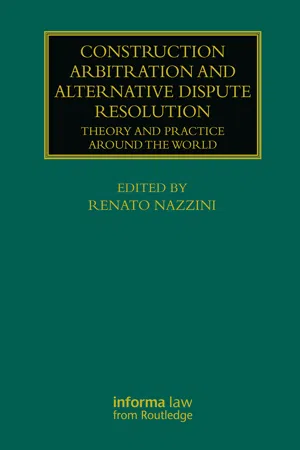
Construction Arbitration and Alternative Dispute Resolution
Theory and Practice around the World
- 396 pages
- English
- ePUB (mobile friendly)
- Available on iOS & Android
Construction Arbitration and Alternative Dispute Resolution
Theory and Practice around the World
About this book
This book provides comprehensive, rigorous and up-to-date coverage of key issues that have emerged in the first quarter of the 21st Century in transnational construction arbitration and alternative dispute resolution (ADR).
Covering four general themes, this book discusses:
-
- the increasing internationalisation of dispute resolution in construction law;
-
- the increasing reliance on technology in the management of construction projects and construction arbitration/ADR;
-
- the increasing prominence of collaborative contracting in construction and infrastructure projects;
-
- the increasing importance of contractual adjudication such as dispute boards in construction and infrastructure projects;
-
- the increasing prevalence of statutory adjudication mechanisms across the world; and
-
- the greater incidence of investment disputes and disputes against States and State entities over construction and infrastructure concessions and agreements.
Tapping on their substantial expertise in practice and in research, the contributor team of senior practitioners and academics in the area of construction law and dispute resolution provide readers with information that balances an intellectually rigorous academic contribution against the backdrop of real concerns raised in practice.
Construction Arbitration and Alternative Dispute Resolution is an invaluable resource for practitioners in the field, academics in arbitration and construction law, and post-graduate students in construction law and dispute resolution.
Frequently asked questions
- Essential is ideal for learners and professionals who enjoy exploring a wide range of subjects. Access the Essential Library with 800,000+ trusted titles and best-sellers across business, personal growth, and the humanities. Includes unlimited reading time and Standard Read Aloud voice.
- Complete: Perfect for advanced learners and researchers needing full, unrestricted access. Unlock 1.4M+ books across hundreds of subjects, including academic and specialized titles. The Complete Plan also includes advanced features like Premium Read Aloud and Research Assistant.
Please note we cannot support devices running on iOS 13 and Android 7 or earlier. Learn more about using the app.
Information
chapter 1
Introduction
Part I
The internationalisation of construction dispute resolution
chapter 2
The problem of the law governing the arbitration clause between national rules and transnational solutions
Introduction
Table of contents
- Cover
- Half Title
- Series
- Title
- Copyright
- Contents
- Notes on the contributors
- Table of cases
- Table of legislation
- Table of international treaties and conventions
- Table of arbitration rules
- Chapter 1 Introduction
- Part I The internationalisation of construction dispute resolution
- Part II Artificial intelligence: a game changer?
- Part III Good faith and collaborative dispute resolution
- Part IV Contractual adjudication: dispute boards in international construction disputes
- Chapter 10 Enforcement of DAB decisions under the FIDIC forms of contract
- Chapter 11 Emergency arbitration and the interplay with other pre-arbitral mechanisms
- Part V Statutory construction adjudication: a global perspective
- Part VI Contracting with the state in the 21st Century
- Index